Similar Posts
Last year, I promised our readers that I would try to create an opus sectile icon, that is an icon that joins different stones together to make an image. I recently had the chance to create something that is a mix of carving and mosaic and is probably as close as I am going to get to fulfilling my promise so I thought I would share the process here.
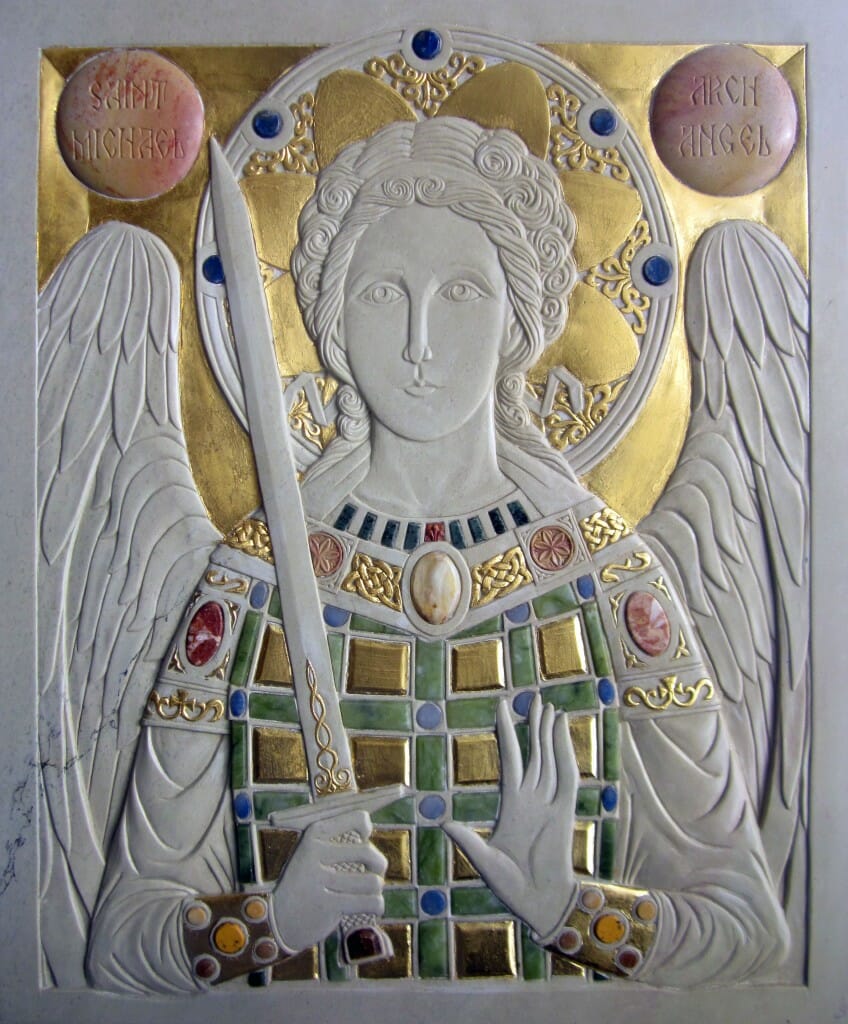
Final icon of St-Michael. Gilded steatite with stone inserts.
The icon was ordered by someone who was looking for an image of his patron saint that was also a precious object, and so I immediately proposed this vision of inserts with gilding on a steatite icon. The basic pattern is based on the famous gold icon made in Constantinople which is now in Venice.
The basic composition remains, although I inverted the hands so that St-Michael could be shown with a sword, and the style is less hieratic and more like a Byzantine painted icon. The face is softer and carved flatter, emphasizing the drawing. Many details were adjusted in the final image, such as the writing, precise patterns and stone insert color.
The icon was carved in its entirety and I then gave the drawing and icon to a friend who is a marble mosaist and has recently started his own workshop with two other mosaists. .
The stones for insterting were cut out and bezeled. We chose serpentine, lapis lazuli, onyx, macauba blue, breccia, travertine, breccia pernice and some pink steatite which I could then carve. Inserting the stones was labor intensive as many stones were oddly shaped to follow the drawing. I had to individually carve each whole to fit the stones.
Once all the stones were put in, I added and carved the final ornamentation on the halo, the clothing and the inscriptions.
Then came the gilding, which was complicated because so much of the gold was in the ornaments and details so many areas were left bare. The gold would stick all over the place, and I often had to scrape out places where the goldleaf bits had accidentally joined to unwanted areas.
In the end, I am very happy with the entire process and I look forward to another opportunity of trying something similar.

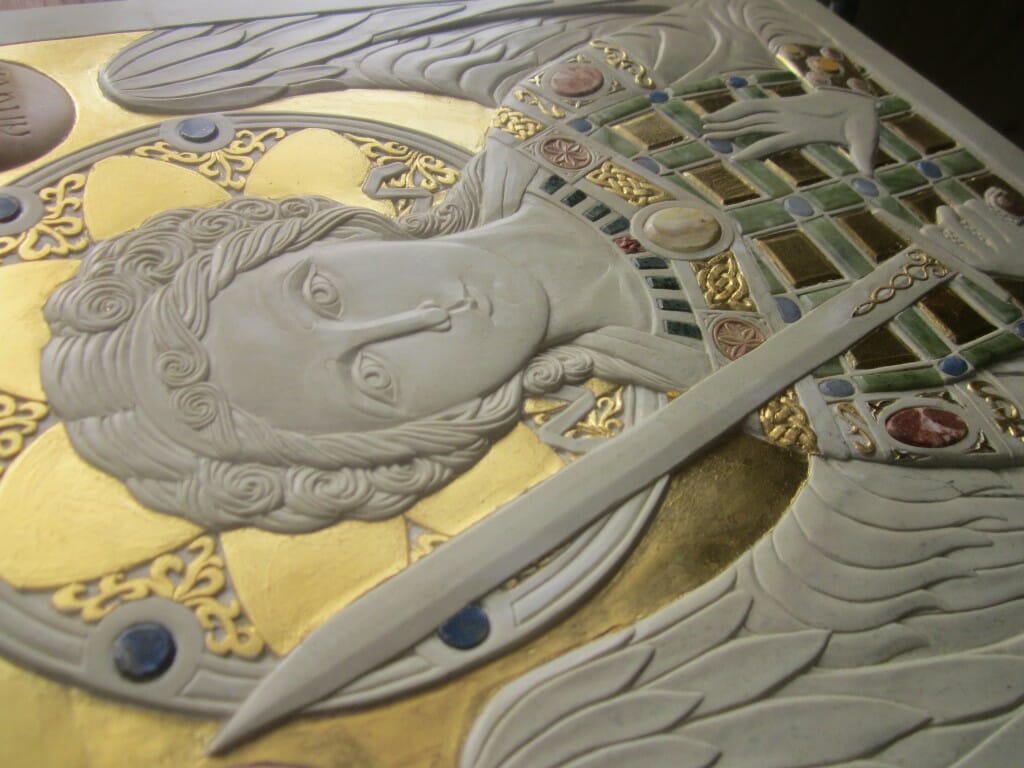
A sense of the flatness of the icon.

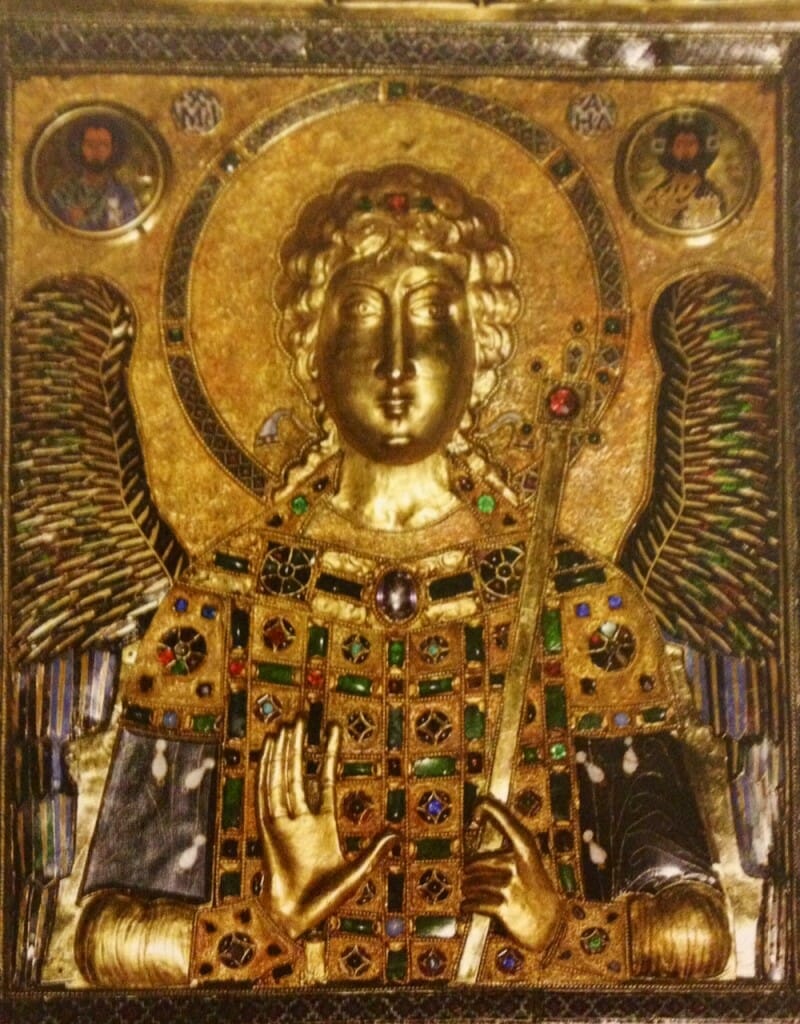
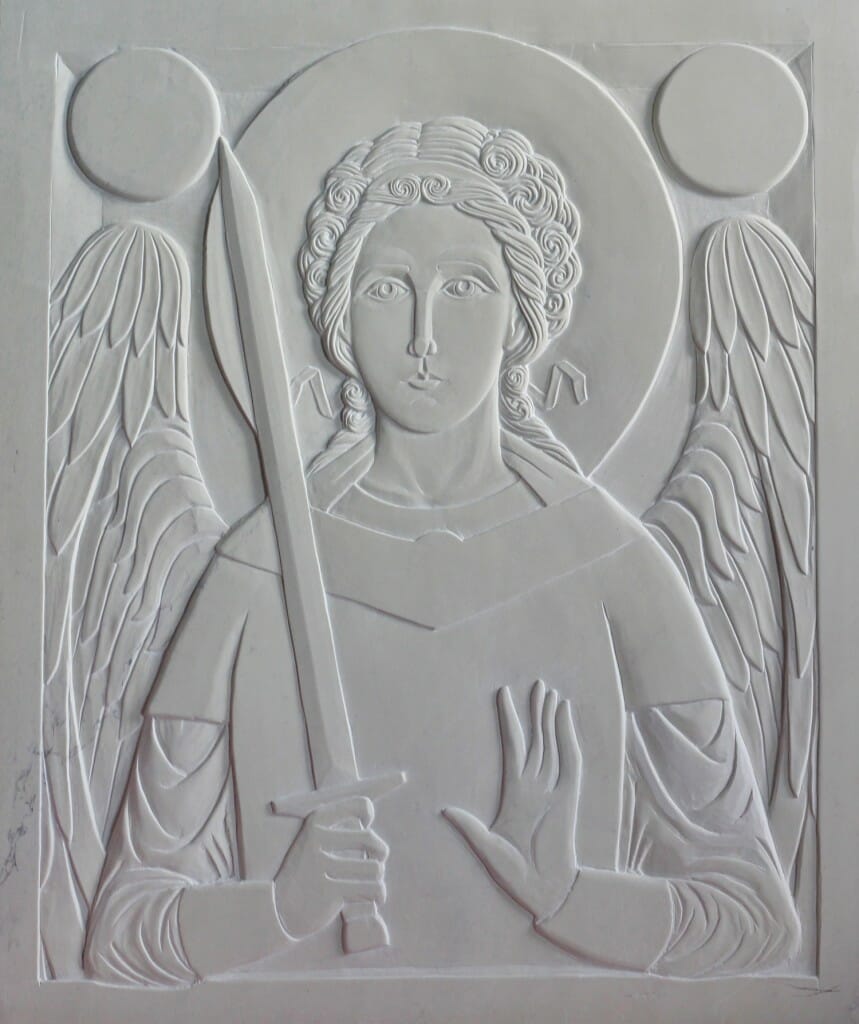
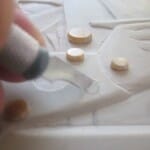
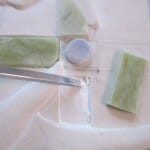
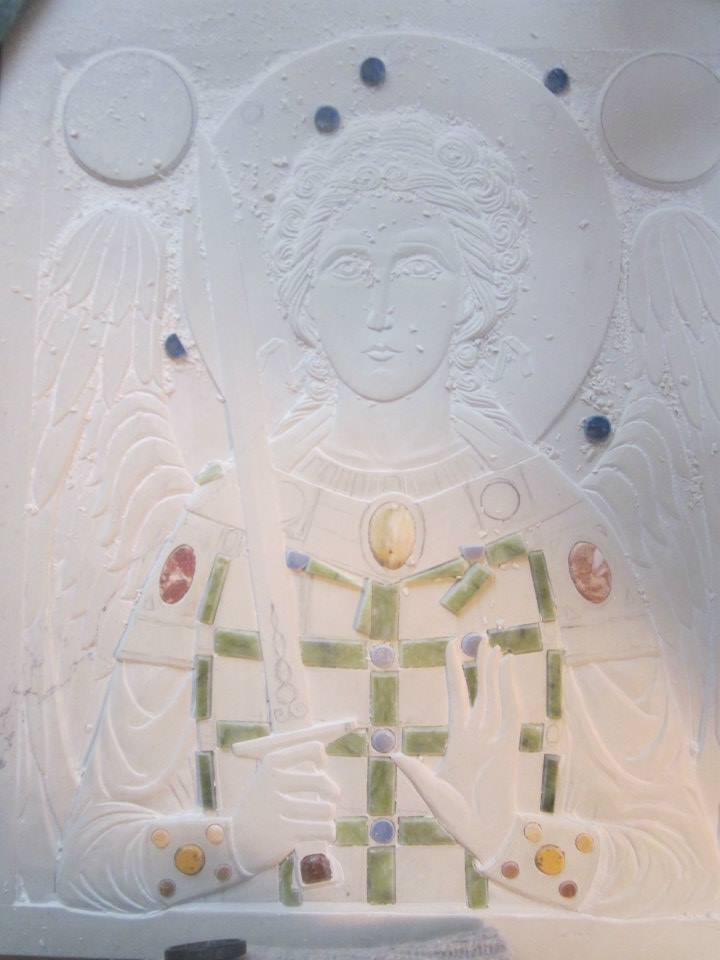

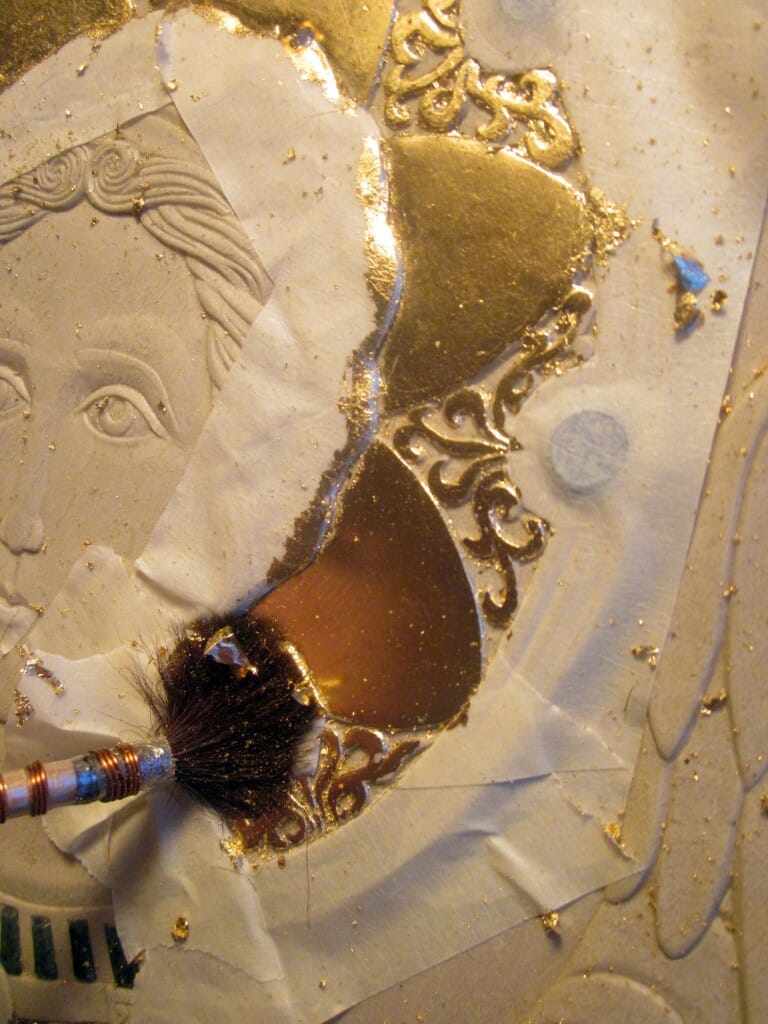
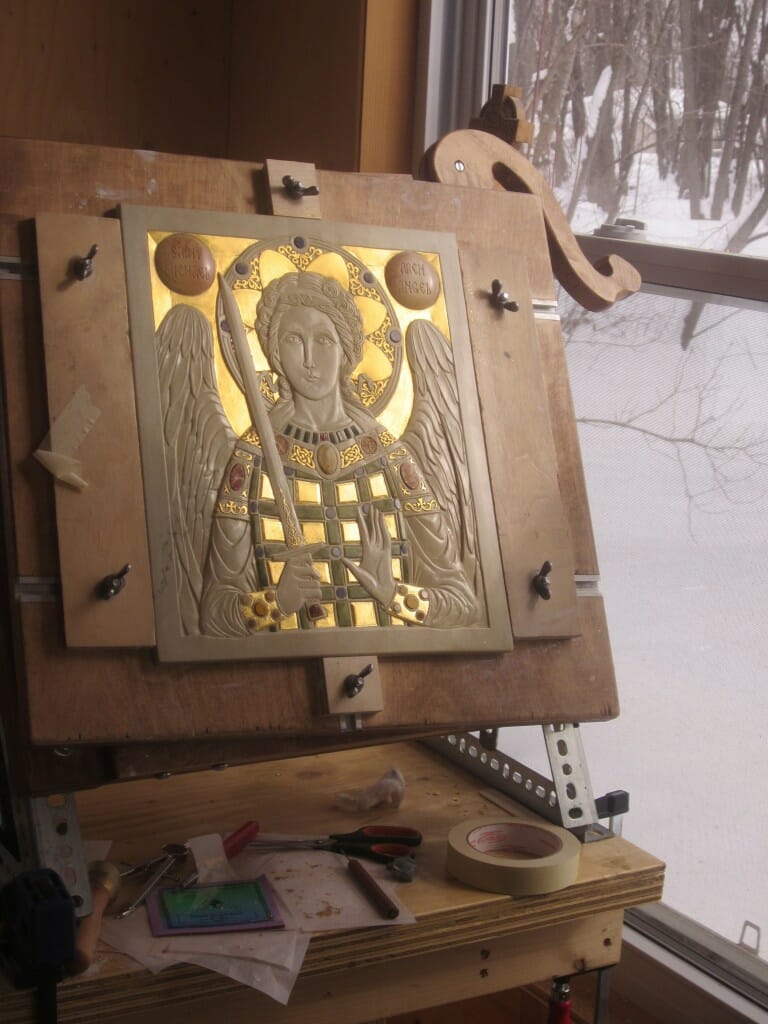
This is stunning Jonathan, thank you for sharing with us.
Beautiful, beautiful, beautiful. Words are inadequate.
This is so beautiful and I know our Fr. Michael would love a picture of it!! Are you making some prints for sale?
Thanks and God bless you for your gift and using it to let others enjoy your works.
I am not in the habit of making prints of my work, though I will contact you if I decide to do it.
This is as beautiful as anything I’ve ever seen. To closely copy an ancient icon is hard enough, but it is really an extraordinary feat to create an icon as distinctive and original as this that is the equal of fine medieval works. And to think that this is only the beginning! What will we see next?
I am especially intrigued by the wing feathers. I cannot remember seeing Byzantine feathers ever sculpted with this kind of life and intensity. They remind me of the extraordinary angel wings in the Pre-Raphaelite paintings by Burne-Jones, or of wings I’ve seen on really good Neoclassical sculpture from the Gilded Age.
As magnificent as ancient Byzantine icons were, it must be admitted that they exhibit relatively little attention to details like feathers, leaves, and ornaments. It is quite wonderful that Jonathan improves on the tradition in these areas, treating the small details of icons with great care. His ornaments and lettering are the equal of details in the finest decorative art of the last century. And yet, they do not seem alien to the medieval liturgical character of the icon, but rather support it perfectly.
Jonathan,
This icon is infused with, and reveals, a sense of the sacred, and thus becomes an instrument for prayer. The Holy Spirit has guided your hand in this effort; may He continue to do so in all your future compositions. Thanks, also, for the sequencing pictures for this icon. I pray for your continued success.
Thanks for the comment, Andrew. You will force in me an appreciation of the Pre-Raphaelites! It is hard for me not see a kind of sensual decadence in their work. Blake in my opinion had rediscovered the symbolism without excess of sentimentality. But then again, when I was 17 I had a strange thing for Gustave Moreau
This is amazing. May your commitment to our traditions continue to expand over the years to come.
Can i suggest that you encase the whole plaque into a wooden casing of some sort leaving narrow a gap between the work and the frame. The whole thing says precious and one cannot imagine touching the plaque itself lest the archangel would swing his blade accross the composition. The work becomes especially alive when you see it in the context of your working station. The warmth of the background highlights the whiteness of the material and makes it appear gentle and balances the coolness of the marble. This all strikes an array of very old sort of rudimentary and arcane things within me but the fact that it is happening where it is, while we are in 2014 AD makes it remarkable. I am trying hard not to congratulate you, because i would aggree it looks like you might have had a bit of help from the sorts of places where things were never created… Can you tell us a bit more about the concurrent events to your making this? we have seen guilding and carving, stones and lettering but i would suggest that there is more than meets the eye. May the mighty archangel shelter and bless you Jonathan.
Thank you for your comment. If St-Michael had a hand in this, I can only thank him!
Jonathan forgive me for coming back to this but can you tell us a bit more about the concurrent events to your making this? Is this the culmination of something, the begining of something else? Is this just a well executed work of art? References? are we seeing more of the archangel or of your hand? forgive my inquisitiveness, i promise it is well disposed; i do not expect a theoretical thesis, i just would genuinely like to know how this came about. You are good with words…i anticipate something equally remarkable for the context. In Christ, Dn Spyridon
I have to admit that I don’t quite know how to answer your question. This object is a confluence of several things: an idea about this technique of inserting stones, a commission that gave the opportunity, a love of carvings wings and a general love for St-Michael. At the same time, everything I do or write is brought out with a desire to show how our arts can be fully traditional without being dead letter and simple copy. I think this approach could define what we are doing at OAJ. Whatever you see in this carving, or in Andrew’s designs or Aidan’s art is all anchored in that desire to create a liturgical art that is alive, immersed in the the past without simply ignoring contemporary sensibilities.
This is so beautiful. Is it possible to purchase this icon or a print of it?
This icon was made on commission for someone. Of course a similar icon can be commissioned , though contact me privately for such a discussion. pageaujonathan@gmail.com
As for prints, I had not intended to make prints though many people are asking for this. It is not something I have done before.
My budget being what it is, I hope you will consider making prints available. There is something very special about this Michael, and we need him.
Hello.
I requested that Jonathan create this carved icon based on my desire to have a unique work that recognizes the Archangel Michael. I have a fairly large collection of icons and last summer photographed all of them for a book. In the process I focused on the faces of the angels that appear in various roles.
Originally I wanted a carving reminiscent of the figure of St. Michael on the front of Coventry Cathedral, but we agreed it is not close enough to traditional iconography.
Looking for another prototype, I was familiar with this piece – it is actually the center of a Bible cover, but didn’t care for the face. ( There is a fascinating book about it called “The Sensual Icon” )
We based the carving then on this Bible cover image, adjusted the face based on other images of angels and my prayerful consideration of what an Archangel might look like. This is not so easy but if one paints (or carves) icons, I believe one has to constantly be asking for help in representing His appearance to those who will subsequently be viewing it.
Jonathan made some sketches, we discussed them, and he took it from there. The sword replaces a scepter, the hands are exchanged, and the gold and jewels adjusted to a more modest budget. You see the result.
This is the fifth piece of sacred art I’ve commissioned (each from a different artist) and I find the process very satisfying.
Michael
Glory to God for this beautiful icon. May it continue to bless and inspire those who see it!